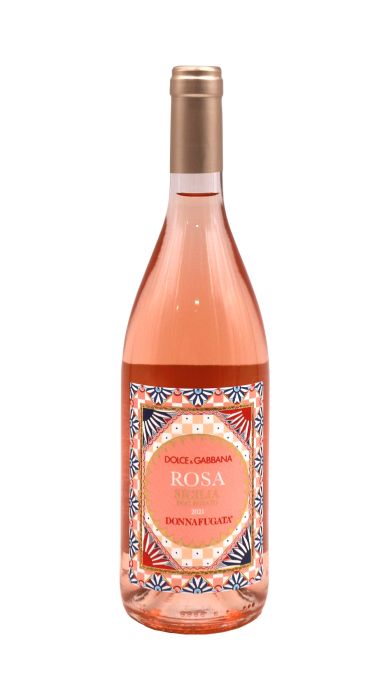Need Help Finding the right wine?
Your personal wine consultant will assist you with buying, managing your collection, investing in wine, entertaining and more.
By continuing, you agree to our privacy policy, consent to cookies, and confirm you are 21 or older.
I have read and agree to the Privacy Policy and Terms of Service.
YOU MUST BE 21 OR OLDER TO CONTINUE
NYC, Long Island and The Hamptons Receive Free Delivery on Orders $300+
Cool Wine Shippers Now Available.
Checkout using your account
Checkout as a new customer
Creating an account has many benefits:

2021 Donnafugata Dolce & Gabbana Rosa Rosato
91 VM
Vinous (Galloni) | 91 VM
| Type of Wine |
Rose
: Rose wine is a versatile drink that involves letting the grape juice soak with the skins for several days, before being allowed to ferment properly. The resulting liquid achieves a beautiful color, ranging from a sweet honey orange to a playful purple hue, adding some color variety to your collection. |
|---|---|
| Varietal |
Proprietary Blend
: Proprietary Blend is a general term used to indicate that a wine is comprised of multiple grape varietals which are either “proprietary” to the winery or is blended and does not meet the required maximum or minimum percentage of a particular varietal. This also is the case for the grape’s place of origin, especially for region, appellation or vineyard designated wines. There are endless examples of blended wines which are labeled as “Proprietary Blend” and in conjunction with each region’s stipulated wine laws and regulations makes for a vast blanket for wines to fall into. Perhaps the simplest example is California; if a wine is to be labeled as Napa Valley Cabernet Sauvignon, it is required to have at least 75% of the varietal (Cabernet Sauvignon) and 85% of the fruit must be cultivated from the Napa Valley wine district. If the wine does not meet the requirements, it is then labeled as Proprietary Blend. |
| Country |
Italy
: Italy is renowned as one of the world’s greatest gastronomic havens; from certified Prosciutto di Parma to the sea-side seafood eateries on the island of Sicily. However, this epicurean experience could not possibly be as hedonistic without the ethereal combination of the country’s plethora of fine wines. It seems unfair that a nation should be able to boast, both, some of the world’s greatest cuisine as well as its greatest wines. Italian wine is one of the most sought after in the world, and has become the second most produced in the world, behind only France. Stretching an impressive 736 miles from northern Italy to the peninsula’s southern tip, the country’s geography generates an enormous array of topography, climate and soil structure. This is an extremely important quality of its winegrowing and making industry which lays claim to nearly 550 different grape varietals, which all desire their own necessities, in terms of terroir and climate. The still red wines of Italy truly characterize the nation’s vast and expansive terroir; Nebbiolo dominates Piedmont, where Barolo and Barbaresco reign king and queen of the region’s production. Hailing from Brunello di Montalcino in Tuscany, the rockstar Sangiovese grape has become synonymous with greatness. Vin Santo sweet wines have taken on a mighty feat of competing with the glorious wines of Sauternes, and of course, Prosecco. Prosecco, located in Trieste (northeast Italy) and its creation of luxuriously effervescent styles of wine has become Italy’s answer to Champagne. The Glera grape variety, which has become synonymous with the name Prosecco, is the main ingredient and is beloved in the appellation where the village of Prosecco’s name has become world renowned. The blurred boundary between Italy and the countries of Slovenia and Austria, where German influence still resonates through Friuli wines. The prevalence of Riesling and other such grape varietals is high in this region and have become extremely popular on today’s market. With nearly 702,000 hectares of grapevines covering the massive and diverse landscape, Italy’s annual average of 48.3 million hectoliters of wine production is second only to France in terms of volume and Spain in terms of hectares of vines. The country is vast and overwhelming when it comes to the culinary arts, but perhaps even this is overshadowed by its production of some of the world’s most sought after wines, whether the omnipresent Chianti to the highly collectible and sought after Amarone della Valpolicalla. |
| Region |
Sicily
: Kissed by dry, warm climate, gorgeous topography, and with tradition so rich, Sicily is any winemaker's dream. The produce grown here becomes first-class goods, and we mean olives, citrus, grains, and not just the wine. Italian culture centers shared meals with family as one of the most important and profound ways of cultivating bonds and community values. This tendency spills over into everything else they do, naturally including viticulture. This makes Sicilian wines uniquely warm and soulful, each bottle telling its own story. Two native grapes roll off the tongue of sommeliers when they first mention Sicily: Nero d'Avola and Catarratto. Luscious, full, vibrant, these grapes, and especially Catarratto in particular, often find their way into the blends of wines from cooler sites in Italy to bring them weight and contrast their acidity. Sicily is home to other grape varietals including Inzolia, Grillo, Grecanico, Frappato and many more. Though you can't really go wrong with Sicilian wines, beginners shouldn't miss out on sweet, exuberant, mouthwatering Marsala. What this mind-boggling elixir delivers is so purely emotional and intense that touches even the most skeptical of souls. In the true spirit of Italy, this beauty combines with virtually any meal you can think of, best suited for large get-togethers with family and celebrations of any kind. |
| Subregion | Val di Demone |
| Producer | Donnafugata |
|---|
Need Help Finding the right wine?
Your personal wine consultant will assist you with buying, managing your collection, investing in wine, entertaining and more.